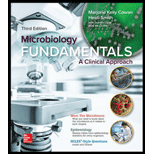
Microbiology Fundamentals: A Clinical Approach
3rd Edition
ISBN: 9781259709227
Author: Marjorie Kelly Cowan Professor, Heidi Smith
Publisher: McGraw-Hill Education
expand_more
expand_more
format_list_bulleted
Question
Chapter 11.2, Problem 13AYP
Summary Introduction
To differentiate:
Difference between the various types of reservoirs, providing examples of each.
Concept introduction:
A group of organisms or the particular environment, in which, an infectious causative agent grow and proliferate in a natural way. A living host of some species is called a reservoir that can be an animal, plant or human. The pathogen can survive inside a reservoir. The natural reservoir can be classified into three types that are a human reservoir, non-human or animal reservoir, and an environmental reservoir.
Expert Solution & Answer
Want to see the full answer?
Check out a sample textbook solution
Students have asked these similar questions
Distinguish between reservoirs and sources, using examples.
Define infectious dose, and explain its role in establishing infection.
Enumerate the measures to prevent transmission of Hospital Associated Infections,?
Chapter 11 Solutions
Microbiology Fundamentals: A Clinical Approach
Ch. 11.1 - Prob. 1AYPCh. 11.1 - Enumerate the sites where normal biota is found in...Ch. 11.1 - Discuss how the Human Microbiome Project is...Ch. 11.1 - Prob. 2NPCh. 11.2 - Differentiate between a microbes pathogenicity and...Ch. 11.2 - Prob. 5AYPCh. 11.2 - Explain the significance of polymicrobial...Ch. 11.2 - Prob. 7AYPCh. 11.2 - Prob. 8AYPCh. 11.2 - Prob. 9AYP
Ch. 11.2 - Prob. 10AYPCh. 11.2 - Prob. 11AYPCh. 11.2 - Draw a diagram of the stages of disease in a humanCh. 11.2 - Prob. 13AYPCh. 11.2 - Prob. 14AYPCh. 11.2 - Define healthcare-associated infection, and list...Ch. 11.2 - Prob. 16AYPCh. 11.2 - Prob. 1MMCh. 11.2 - Prob. 3NPCh. 11.2 - Prob. 2MMCh. 11.2 - Prob. 4NPCh. 11.2 - Prob. 5NPCh. 11.2 - Q. Can you think of what type of incident might...Ch. 11.2 - Prob. 6NPCh. 11.3 - Summarize the goals of epidemiology, and...Ch. 11.3 - Prob. 18AYPCh. 11.3 - Prob. 19AYPCh. 11.3 - Discuss the three major types of epidemics, and...Ch. 11 - Prob. 1NPCh. 11 - Prob. 1QCh. 11 - Prob. 2QCh. 11 - Prob. 3QCh. 11 - Prob. 4QCh. 11 - Prob. 5QCh. 11 - Discuss the role of endospores in ensuring the...Ch. 11 - Prob. 7QCh. 11 - Correlate the stages in the course of an...Ch. 11 - Prob. 9QCh. 11 - Prob. 10QCh. 11 - Prob. 11QCh. 11 - Prob. 12QCh. 11 - Prob. 13QCh. 11 - Prob. 14QCh. 11 - Prob. 15QCh. 11 - Prob. 16QCh. 11 - Prob. 17QCh. 11 - Prob. 18QCh. 11 - The number of cases, including new cases as well...Ch. 11 - Prob. 20QCh. 11 - One important way to critically analyze a study...Ch. 11 - Prob. 1VC
Knowledge Booster
Learn more about
Need a deep-dive on the concept behind this application? Look no further. Learn more about this topic, biology and related others by exploring similar questions and additional content below.Similar questions
- List examples of physical and chemical barriers toinfection.arrow_forwardGiven that every client cannot be fully screened forinfections, what precautions are essential to limit thetransmission of microbes that are agents of disease?arrow_forwardClassify acute and chronic diseases according to infectivity and communicability.arrow_forward
- Why is it necessary to obtain an acute and aconvalescent blood sample to monitor infections?arrow_forwardExplain why it is not possible for someone to contract a disease through a vaccine, but still have side effects such as fever or weakness.arrow_forwardThe Klein and Mancinelli (2021) textbook describes a Level IX and a Level X on the RLA. How would a clinician working in an outpatient facility find those extra levels useful when treating their clients with TBI?arrow_forward
arrow_back_ios
arrow_forward_ios
Recommended textbooks for you
 Human Physiology: From Cells to Systems (MindTap ...BiologyISBN:9781285866932Author:Lauralee SherwoodPublisher:Cengage Learning
Human Physiology: From Cells to Systems (MindTap ...BiologyISBN:9781285866932Author:Lauralee SherwoodPublisher:Cengage Learning

Human Physiology: From Cells to Systems (MindTap ...
Biology
ISBN:9781285866932
Author:Lauralee Sherwood
Publisher:Cengage Learning
Photosynthesis & Respiration | Reactions | Chemistry | FuseSchool; Author: FuseSchool - Global Education;https://www.youtube.com/watch?v=3XIyweZg6Sw;License: Standard YouTube License, CC-BY